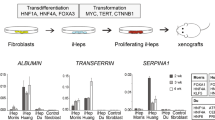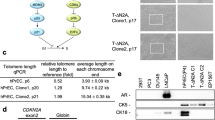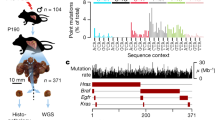Abstract
Limited lifespan in normal diploid mammalian cells in culture is well documented1–3 and there is evidence that it is also a property of normal tissues serially transplanted in vivo4,5. In contrast, in favourable growth conditions, cells derived from tumours or premalignant tissue often exhibit unlimited proliferative potential (immortality) both in vitro and in vivo2,4,6–10. Malignant transformation of diploid cells in culture by carcinogens has been clearly demonstrated in several laboratories2,11–13. However, although it has been frequently reported that establishment in culture is one of many alterations in cell behaviour associated with transformation, the induction of immortality and its role in malignancy have not previously been subjected to serious scientific examination. Here, we show that treatment of Syrian hamster cell cultures with carcinogenic chemicals can induce rare immortal variants, the progeny of which then frequently progress to anchorage independence and malignancy after a further period of growth. In addition, by studying the properties of cell lines that are either immortal or anchorage-independent but not both, we have obtained evidence that immortality, although insufficient by itself, may be a prerequisite for malignant transformation.
This is a preview of subscription content, access via your institution
Access options
Subscribe to this journal
Receive 51 print issues and online access
$199.00 per year
only $3.90 per issue
Buy this article
- Purchase on Springer Link
- Instant access to full article PDF
Prices may be subject to local taxes which are calculated during checkout
Similar content being viewed by others
References
Hayflick, L. & Moorhead, P. Expl Cell Res. 25, 585–621 (1961).
Ponten, J. Biochim. biophys. Acta 458, 397–422 (1976).
Barrett, J. C. et al. Cancer Res. 37, 3815–3823 (1977).
Daniel, C. W., Aidells, B. D., Medina, D. & Faulkin, L. J. Fedn Proc. 34, 64–67 (1975).
Hellman, S., Botnick, L. E., Hannon, E. C. & Vigneulle, R. M. Proc. natn. Acad. Sci. U.S.A. 75, 490–494 (1978).
Klein, G. Cancer Res. 19, 343–358 (1959).
DiPaolo, J. A., Nelson, R. L. & Donovan, P. J. J. natn. Cancer Inst. 46, 171–181 (1971).
Sinkovics, J. G., Gyorkey, F., Kusyk, C. & Siciliano, M. J. Meth. Cancer Res. 14, 243–323 (1978).
Klein, G. Proc. natn. Acad. Sci. U.S.A. 76, 2442–2446 (1979).
Rheinwald, J. G. & Beckett, M. A. Cancer Res. 41, 1657–1663 (1981).
Berwald, Y. & Sachs, L. J. natn. Cancer Inst. 35, 641–661 (1965).
DiPaolo, J. A., Nelson, R. L. & Donovan, P. J. Cancer Res. 31, 1118–1127 (1971).
Barrett, J. C. & Ts'o, P. O. P. Proc. natn. Acad. Sci. U.S.A. 75, 3761–3765 (1978).
Franks, L. M. & Wilson, P. D. Int. Rev. Cytol. 48, 55–139 (1977).
Kakunaga, T. Proc. natn. Acad. Sci. U.S.A. 75, 1334–1338 (1978).
Lewis, L. et al. J. Cell Sci. 53, 21–36 (1982).
Newbold, R. F. & Brookes, P. Nature 261, 52–54 (1976).
Newbold, R. F., Warren, W., Medcalf, A. S. C. & Amos, J. Nature 283, 596–599 (1980).
Bouck, N. & DiMayorca, G. Nature 264, 722–727 (1976).
Bellet, A. J. D. & Younghusband, H. B. J. cell. Physiol. 101, 33–48 (1979).
Marin, G. Expl Cell Res. 125, 31–36 (1980).
Poiley, J. A., Schuman, R. F. & Pienta, R. J. In Vitro 14, 405–412 (1978).
Freedman, V. H. & Shin, S. J. natn. Cancer Inst. 58, 1873–1875 (1977).
Namba, M., Nishitani, K. & Kimoto, T. Japan J. exp. Med. 48, 303–311 (1978).
Orgel, L. E. Nature 243, 441–445 (1973).
Bell, E. et al. Science 202, 1158–1163 (1978).
Holliday, R., Huschtscha, L. I. & Kirkwood, T. B. L. Science 213, 1505–1508 (1981).
Sun, N. et al. Cancer Res. 41, 1669–1676 (1981).
Peehl, D. M. & Stanbridge, E. J. Proc. natn. Acad. Sci. U.S.A. 78, 3053–3057 (1981).
Author information
Authors and Affiliations
Rights and permissions
About this article
Cite this article
Newbold, R., Overell, R. & Connell, J. Induction of immortality is an early event in malignant transformation of mammalian cells by carcinogens. Nature 299, 633–635 (1982). https://doi.org/10.1038/299633a0
Received:
Accepted:
Issue Date:
DOI: https://doi.org/10.1038/299633a0
This article is cited by
-
Deep neural network for the determination of transformed foci in Bhas 42 cell transformation assay
Scientific Reports (2021)
-
Activating mutations in BRAF disrupt the hypothalamo-pituitary axis leading to hypopituitarism in mice and humans
Nature Communications (2021)
-
Melanocytic nevi and melanoma: unraveling a complex relationship
Oncogene (2017)
-
Carcinogen-specific mutational and epigenetic alterations in INK4A, INK4B and p53 tumour-suppressor genes drive induced senescence bypass in normal diploid mammalian cells
Oncogene (2013)
-
Comparative biology of mouse versus human cells: modelling human cancer in mice
Nature Reviews Cancer (2003)
Comments
By submitting a comment you agree to abide by our Terms and Community Guidelines. If you find something abusive or that does not comply with our terms or guidelines please flag it as inappropriate.



